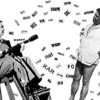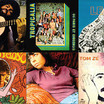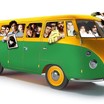Ilumencarnados seres

manoel barenbein
Interviews
Ana de Oliveira – Manoel, how did you meet the people who soon afterwards would launch the Tropicalista movement?
Manoel Barenbein – I had already worked as a promoter, I was the production assistant of Walter Silva, who produced all the Teatro Paramount shows, and also frequented Teatro de Arena, where I met Gil. In 66, I had already produced “A Banda,” by Chico Buarque, and recorded “Disparada,” by Geraldo Vandré. But the process took its shape when I left RGE to undertake the position of art director at Phonogram, soon before the Record Festival of 67.
Ana de Oliveira – Did you suffer professional retaliation or felt stigmatized for having worked with the Tropicalistas?
Manoel Barenbein – Yes, but perhaps due to my attitude I had no problems with that. Differently from nowadays, when you have to beg for a radio station to play a song, at that time, apart from a few purists, radio staff would queue to know if I had already received the new Caetano’s vinyl acetate.
Ana de Oliveira – How was the studio atmosphere during the recording sessions of Caetano, Gil, Gal, Mutantes, Rogério Duprat and Tom Zé?
Manoel Barenbein – It was funnier than a party. When I took a guitar distorter to the studio for the first time, the technicians wanted to kill me because they were the ones who adjusted everything, everyday, making sure that nothing would come out distorted. And all of a sudden, a cracked guy arrived with a little box, treaded upon the pedal and the guitar sound was completely distorted. Once, Rita Lee popped in for a night recording of the Mutantes and took out a flit pump from her case. The technician didn’t have a clue of what she meant with that. I asked Rita what was that and she said: “the drums’ ximbau.” The plump kept the score of the ximbau.
Ana de Oliveira – And what about the albums recorded during the confinement of Caetano and Gil in Salvador? The recording sessions’ atmosphere was no longer so light, was it? It seems that you faced difficult times to produce their albums in that period.
Manoel Barenbein – The white album by Caetano, the one that has “Irene” and “Chuvas de Verão,” and the album by Gil that has “Volkswagen Blues,” were both made in an inverted way because of the confinement. They were broke. It was a way to get them some money. But the company, which had a cast of subversives – Caetano, Gil, Elis Regina, Chico Buarque – could not act openly. We produced the albums and anticipated the copyrights. We left Rio with two stereophonic recording sets, microphones and all the rest. We rented a studio for radio advertisements, which was monophonic. We had to replace their equipment by ours. When I came back to the hotel, I saw two gentlemen from the Federal Police waiting for me. They asked whether I was in charge of Caetano and Gil. I told them about the two albums. They replied: “Mister, do you know that they can’t make public manifestations?” I said that I knew it, but that it was not public, it was being made inside a studio. I showed them the lyrics, which had been licensed by the censorship, and provided them with the address. The sessions, which lasted about two weeks, were very tense.
Ana de Oliveira – How would you compare the phonographic market of that time to today’s?
Manoel Barenbein – They are two completely different consumption worlds. We listen to “Alegria, Alegria” nowadays, after some decades, and feel pleasure. But we don’t have the patience to listen to something from four or five years ago. At that time, we had two radio stations: Difusora and Excelsior. Today, each city has eighteen FM stations. Today, we listen to a song seventy times per day, the artists show up sixty nine times per month on TV… There is no comparison, neither in terms of technology or pleasure.





















